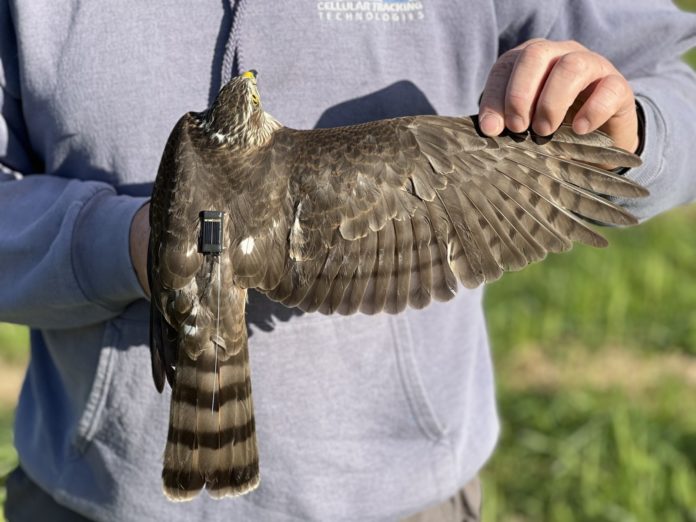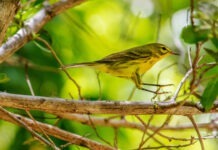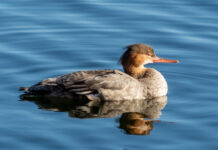
I’d just spent three days up at the Florida Keys Hawkwatch at Curry Hammock State Park in Marathon and was finally catching up on things in my life, so I wasn’t planning on leaving the rock for a while. But then I got the text – the sharpie was coming down the Keys. It was in Tavernier, but heading south.
I pulled my Nalgene bottle out of the drying rack, asked the dog not to eat any more shoes while I was gone, grabbed my camera and binoculars, and headed back up to Marathon. The whole way up, I was worried. What if I missed something this cool?
Sharpie is birder slang for sharp-shinned hawk. It is the smallest of the three North American accipiters – a family of long-tailed, short-winged hawks that specialize in flying at high speeds through wooded areas densely packed with bushes and trees and nary brushing a wingtip. They are fast and sneaky and surprisingly long-legged, though you generally wouldn’t notice the long-legged bit unless you had actually seen one in hand.
This particularly sharpie – officially known as SSHA1 – had been trapped and held in hand about three weeks prior, up in Cape May, New Jersey, by a woman named Tricia Miller. The bird, a female, had been held just long enough for her husband, Michael Lanzone, to attach a tiny electronic transmitter to its back with a small harness, and then it was released.
Miller is executive director and senior research wildlife biologist at Conservation Science Global, a non-profit research group oriented towards conservation and natural resources management, a.k.a. studying birds and their behaviors in order to figure the best ways to protect them. Lanzone is the CEO at Cellular Tracking Technologies, a company that produces electronic devices to track and monitor wildlife.
They were collaborating on a project, funded by the Cape May Point Science Center, which wanted to understand how four species of raptors – sharp-shinned hawks, Cooper’s hawks, red-tailed hawks, and red-shouldered hawks – used local habitat as they migrated through the surrounding region. They were doing it using some pretty recently developed technology.
Telemetric devices attached to birds are not a new thing. VHF transmitters have been used for several decades, allowing scientists to track birds as they move through the landscape.
Tracking via VHF, though, generally requires a directional antenna and a car or an airplane to trail the bird and chart its movements.
Satellite trackers have also existed for some time, but they tend to be expensive and require pricey annual subscriptions. And telemetric devices attached to birds need to be under 3% of their body weight so as not encumber them in a potentially destructive manner. There isn’t a satellite tracker small enough to attach to a sharp-shinned hawk. On average, the females weigh about 175 grams, and the males weigh about 100 grams – or the same as your average-sized banana.
The CTT tracker they’d attached to the sharpie used cell phone technology. It weighed just 3.5 grams, and included a battery and a solar panel. As long as the bird was in cell phone range, they could know where it was. They could follow the bird using an app on their phone. They could even change the check-in intervals from, say, once every 20 minutes, to once every four hours.
While Miller’s project was focused on how the birds were using the habitat in the Cape May peninsula, there were some serious spillover benefits.
“It’s giving us a pretty cool picture of how that bird moved from Cape May, crossed Delaware Bay, crossed Chesapeake Bay, and then moved down the east coast, and then hit Florida and went down the west coast,” she said.
It’s the kind of detailed knowledge that did not exist before.
She told me all this during those three days I was up at the Hawkwatch site at Curry Hammock State Park. She and Lanzone and some friends had been at the Raptor Research Foundation conference in Fort Lauderdale, and made the trip down to spend some time at the count. (And also, possibly, as a chance to revisit some familiar places, as Miller had been part of the earliest iteration of the Florida Keys Hawkwatch when it began in 1996.)
While they were in the Keys, the sharpie, according to the app, was milling about in the eastern edge of the Everglades. There was a possibility the bird would migrate through the Keys and they’d have a chance to see it. Re-sighting an individual bird that you’d caught three weeks before and 1,300 miles away would be kind of amazing. The bird never made the move toward the Keys, though, and eventually Miller and Lanzone had to head to the airport.
In the following days the bird actually moved north, through Miami, Boca Raton and Palm Beach. I had mostly forgotten about her, until that text said she was moving. The bird had spent the night in the Point Lowe neighborhood in Tavernier. In the morning, she had hunted around for a time – sharpies generally feed on smaller songbirds – and then started south.
It was pretty busy when I got to the platform. Luis Gles and Mariah Hryniewich were nearly as keyed up as I. There were a good number of sharp-shins moving through, but also good numbers of peregrine falcons and American kestrels. Most of the birds were pretty high and ou toward the highway.
Miller sent another screen grab of the tracking map – the bird was just north of Long Key.
“It’s about 21 miles away now!” she said. We all kept our eyes peeled.
Over the next hour we counted 85 sharp-shinned hawks. We counted another 52 in the hour after that.
Was one of them SSHA1? It’s hard to say. The check in from her tracker at 21 miles north was the last the bird has been heard from. Cellular coverage is pretty solid in the Keys, so most likely the bird lit out for Cuba – maybe just north of where we were, maybe just south of where we were. Maybe we saw it and didn’t know it. But Cuba’s cell system does not connect with ours, or at least not the LTE system that the tracker uses, so it may be a while before we learn exactly what happened.
SSHA1 has already helped paint a much fuller picture about how sharp-shinned hawks migrate, filling a lot of unknowns about timing and behaviors. No one really knows the likelihood of a sharpie crossing such a large body of water not once, but twice. But if the bird makes it back from Cuba in the spring, we will have a fuller picture still. I, for one, will be waiting by the phone.
























